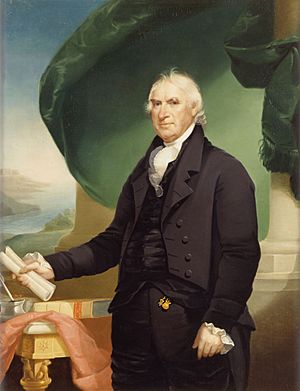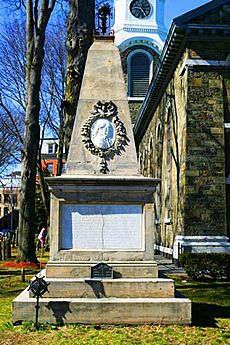George Clinton (vice president) facts for kids
Quick facts for kids
George Clinton
|
|
|---|---|

Portrait by Ezra Ames, 1814
|
|
| 4th Vice President of the United States | |
| In office March 4, 1805 – April 20, 1812 |
|
| President |
|
| Preceded by | Aaron Burr |
| Succeeded by | Elbridge Gerry |
| 1st Governor of New York | |
| In office July 1, 1801 – June 30, 1804 |
|
| Lieutenant | Jeremiah Van Rensselaer |
| Preceded by | John Jay |
| Succeeded by | Morgan Lewis |
| In office July 30, 1777 – June 30, 1795 |
|
| Lieutenant | Pierre Van Cortlandt |
| Preceded by | Office established |
| Succeeded by | John Jay |
| Delegate to the Continental Congress from New York | |
| In office May 15, 1775 – July 8, 1776 |
|
| Member of the New York General Assembly from Ulster County | |
| In office 1768–1775 |
|
| Acting President of Columbia University | |
| In office 1784–1787 |
|
| Preceded by | Benjamin Moore (acting) |
| Succeeded by | William Samuel Johnson |
| Personal details | |
| Born | July 26 [O.S. July 15] 1739 Little Britain, Province of New York, British America |
| Died | April 20, 1812 (aged 72) Washington, D.C., U.S. |
| Resting place | Old Dutch Churchyard, Kingston, New York, U.S. |
| Political party | Democratic-Republican |
| Spouse |
Cornelia Tappen
(m. 1770; died 1800) |
| Children |
|
| Parents | Charles Clinton (father) Elizabeth Denniston (mother) |
| Signature |  |
| Military service | |
| Allegiance | |
| Branch/service | |
| Rank | Lieutenant (GB) Brigadier general (US) |
| Unit | Defiance |
| Battles/wars | French and Indian War American Revolutionary War |
George Clinton (July 26, 1739 – April 20, 1812) was an important American soldier and politician. He is known as one of the Founding Fathers of the United States.
Clinton was a member of the Democratic-Republican Party. He served as the fourth Vice President of the United States from 1805 until he passed away in 1812. He also served as the first Governor of New York for many years, from 1777 to 1795 and again from 1801 to 1804. He is one of only two Vice Presidents who served under two different presidents.
Contents
Early Life and Military Service
George Clinton was born in 1739 in Little Britain, New York. His parents, Charles and Elizabeth Clinton, had moved from Ireland. They came to America to escape unfair laws against their religion.
George's father was a farmer and surveyor. He was also involved in New York's government. This inspired George's interest in politics. George Clinton was the brother of General James Clinton. He was also the uncle of future New York governor, DeWitt Clinton.
French and Indian War Experience
During the French and Indian War, George Clinton first served on a privateer ship called Defiance. This ship operated in the Caribbean Sea. Later, he joined the local militia, where his father was a Colonel.
George became a Lieutenant in the militia. In 1758, he joined his father in a key battle. They helped capture Fort Frontenac from the French. This victory cut off important supply lines for the French.
Political Beginnings
George Clinton's father had impressed the governor of New York. Because of this, George was offered a job as sheriff in 1748. His father turned it down, but George later became the Clerk of the Ulster County Court. He held this job for 52 years, starting in 1759.
After the war, George Clinton studied law in New York City. He became a lawyer in 1764 and a district attorney a year later. From 1768 to 1775, he was a member of the New York General Assembly. He was known for opposing British rule.
Role in the Revolutionary War
As a member of the New York General Assembly, Clinton spoke out against British policies. In 1775, he tried to get the Assembly to support the Continental Congress. When his idea was rejected, he warned that the colonies would soon have to fight.
He was chosen as one of New York's delegates to the Second Continental Congress. He supported American independence very strongly. He also became a brigadier general in New York's state militia. His job was to protect the Hudson River from British attacks. He built two forts and stretched a giant chain across the river to stop British ships.
Serving as Wartime Governor
On March 25, 1777, Clinton became a brigadier general in the Continental Army. In June 1777, he was elected both Governor and Lieutenant Governor of New York. He chose to be Governor and took office on July 30. He was re-elected five times, serving until June 1795.
Even as governor, he kept his military role. He commanded forces at Fort Clinton and Fort Montgomery. He was known for being tough on Loyalists, who were people loyal to Britain. He used money from selling their seized properties to help keep taxes low.
Clinton was a friend and supporter of George Washington. He helped supply food to the troops at Valley Forge. In 1783, he helped negotiate the departure of British troops from the United States.
A National Leader
In the early 1780s, Clinton first supported a stronger federal government. However, he later opposed giving Congress the power to impose tariffs (taxes on imported goods). He worried this would hurt New York's income.
He became a leading opponent of the U.S. Constitution. He felt it gave too much power to the federal government. After the Constitution was approved, Clinton worked to add amendments (changes) to limit the federal government's power. These changes became the United States Bill of Rights in 1791.
Presidential Elections
In the first U.S. presidential election (1788-1789), many people who opposed the Constitution supported Clinton for Vice President. However, John Adams won the Vice Presidency.
In the 1792 election, Clinton was chosen as the Democratic-Republican Party's candidate for Vice President. While George Washington was re-elected President, Clinton lost the Vice Presidency to John Adams.
Clinton did not run for governor in 1795. He returned to politics in 1800 and was elected governor again in 1801. He served until 1804. With 21 years of service, he was the longest-serving governor of a U.S. state for a very long time.
Dispute with Vermont
Before 1764, the land that is now Vermont was claimed by both New Hampshire and New York. Many settlers moved there based on New Hampshire's laws. But in 1764, King George III gave the land to New York. New York did not recognize the settlers' land claims.
Because of this, the settlers resisted New York's authority. In 1777, they declared themselves an independent state called Vermont. For years, Vermont tried to join the United States. However, New York and Governor George Clinton strongly opposed this.
In 1784, New York's government, with Clinton's support, threatened to use force against Vermont. Eventually, in 1790, New York agreed to give up its claims. Vermont was then admitted to the Union as the 14th state in 1791.
Serving as Vice President (1805–1812)
George Clinton was chosen as President Thomas Jefferson's running mate in the 1804 election. He replaced Aaron Burr as Vice President. Clinton was chosen because he had served the public for a long time and was popular in New York.
When they won, Clinton became the fourth Vice President of the United States. He was the first Vice President to serve under two different presidents: Thomas Jefferson and James Madison.
During his first term under Jefferson, Clinton felt left out. Jefferson did not want to make his Vice President too powerful. Clinton also found it hard to lead the Senate meetings. Many senators thought he was not very good at it.
Clinton tried to run for president in the 1808 election. However, the party chose James Madison instead. Even though Clinton ran against Madison, he was still re-elected as Vice President. After this election, Clinton and his supporters often disagreed with President Madison.
Death and Legacy
George Clinton passed away from a heart attack on April 20, 1812. He was 72 years old. He was the first Vice President to die while still in office.
He was first buried in Washington, D.C. Later, in 1908, his body was moved to the Old Dutch Churchyard in Kingston, New York.
Clinton's nephew, DeWitt Clinton, later ran for president in 1812. He challenged James Madison but was defeated.
Family Life
On February 7, 1770, George Clinton married Sarah Cornelia Tappen. They had five daughters and one son. Sadly, only three of their children lived longer than their father.
- Catharine Clinton (1770–1811)
- Cornelia Tappen Clinton (1774–1810)
- George Washington Clinton (1778–1813)
- Elizabeth Clinton (1780–1825)
- Martha Washington Clinton (1783–1795)
- Maria Clinton (1785–1829)
Honoring George Clinton

Historian Alan Taylor called George Clinton "The smartest politician in Revolutionary New York." He was good at understanding people and connecting with them. His marriage also helped his political standing in Ulster County.
Several places are named after him, including:
- Clinton County, New York
- Clinton County, Ohio
- The village of Clinton, Oneida County, New York
- Clintonville, Columbus, Ohio
In 1873, New York state gave a bronze statue of Clinton to the United States Capitol. He was also shown on a copper coin made in New York in 1787.
George Clinton is depicted in the famous painting Declaration of Independence by John Trumbull. Even though he wasn't there when it was signed, he was an important figure of that time. This painting has appeared on the back of the United States two-dollar bill.
In 2000, the State of New York officially renamed the Kingston-Rhinecliff Bridge in his honor.
Images for kids
-
Clinton's pew, St. Paul's Chapel in New York City
See also
 In Spanish: George Clinton (vicepresidente) para niños
In Spanish: George Clinton (vicepresidente) para niños




